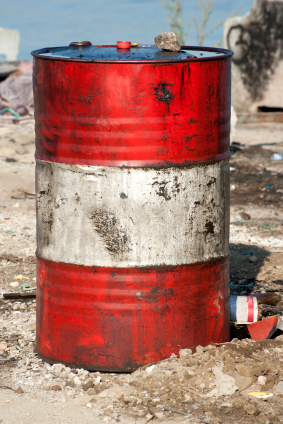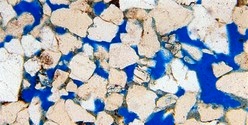Four days of oil
The long-awaited news of oil in the Falkland Islands arrived in May last year when UK company Rockhopper Exploration drilled a successful well in the North Falkland Basin. After testing a second well, the estimated volume of recoverable oil in the field, called Sea Lion, was upped last month to 325 million barrels. A barrel is one bathtub, or 42 gallons, or 159 litres, or 0.159 m3. Let's be scientific and stick to SI units: the discovery is about 52 million cubic metres. Recoverable means the oil can be produced with foreseeable technology; about half the oil will likely not be produced and remain in the ground forever. Or until humans are desperate enough to get it out.
 On its own, a claim of 325 million barrels is meaningless to those outside the oil business. But this is a good-sized discovery, certainly a company-maker for a small player like Rockhopper. But as we read news of recent big discoveries in the Gulf of Mexico by BP, Chevron and ExxonMobil, it's worth having some sort of yardstick to help visualize these strange units and huge numbers.
On its own, a claim of 325 million barrels is meaningless to those outside the oil business. But this is a good-sized discovery, certainly a company-maker for a small player like Rockhopper. But as we read news of recent big discoveries in the Gulf of Mexico by BP, Chevron and ExxonMobil, it's worth having some sort of yardstick to help visualize these strange units and huge numbers.
 A fun exercise is to imagine some large object, a building perhaps, being filled with oil. Let's take the Empire State Building, since it's fairly easy for most people to conjure up. The building has 102 storeys, is well over 400 m tall, and has a convenient volume: a shade over 1 million cubic metres.
A fun exercise is to imagine some large object, a building perhaps, being filled with oil. Let's take the Empire State Building, since it's fairly easy for most people to conjure up. The building has 102 storeys, is well over 400 m tall, and has a convenient volume: a shade over 1 million cubic metres.
This makes it easy. The oil from the Sea Lion field, when it's produced, would fill the Empire State Building 52 times! At $80 a barrel, it's worth about $26 billion.
But more interesting to a geologist is this: how much reservoir rock does it take to hold that much oil? Imagine the building is a solid block of porous sandstone. What we might call the gross rock volume of the Empire State Building is 1 million cubic metres. Since between 70 and 90 percent of a typical sandstone consists of sand grains (non-blue bits in the image below), we have to discount most of this volume for our purposes. Let's assume a porosity of 20% and call the total pore volume 200 000 m3.
Now we have to apply another discount. Sand is often saturated with water when it is deposited, in a delta for example, and this is its natural state during burial too. When oil later fills a sandstone, not all of the water can leave the rock, so a reservoir rock can never be completely saturated with oil. Usually, only about 70 or 80 percent of the pore volume is filled. Let's call it 75%, making the oil pore volume 150 000 m3.
We're not done yet. Oil has the inconvenient property of shrinking when it comes up from the subsurface. As the pressure is reduced, most oils release natural gas, just as a fizzy drink releases CO2 when the pressure is released by opening the cap. Furthermore, the oil cools down from perhaps 100°C or more. The net result is shrinkage by about 10–30%. Let's say each reservoir barrel is worth only 0.85 reservoir barrels in the stock tank. We're left with 127 000 m3, only 12.7% of the total building volume.
So now we need 52 million ÷ 127 000 = 409 Empire State Buildings. Given our assumptions, this is how big the sponge needs to be to hold 325 million barrels. Since we may only produce about half the oil, we'll need a total of 818 Empire State Buildings in the ground to get our 325 million barrels out.
 By the same math, we can calculate that a one-billion-barrels-in-place field in the Gulf of Mexico (the sort that makes headlines), would require about 1260 Empire States in the ground. The Surmont heavy oil field in Alberta has about 25 billion barrels of bitumen in place: 31 500 buildings, which would cover Manhattan more than four times. It is but a drop compared to the rest of Alberta.
By the same math, we can calculate that a one-billion-barrels-in-place field in the Gulf of Mexico (the sort that makes headlines), would require about 1260 Empire States in the ground. The Surmont heavy oil field in Alberta has about 25 billion barrels of bitumen in place: 31 500 buildings, which would cover Manhattan more than four times. It is but a drop compared to the rest of Alberta.
Another way to think about Rockhopper's 325 million barrel discovery is in terms of how it will help meet global demand for crude. Or won't help: we (you and I and the rest of humanity) use about 87 million barrels of oil every day. Almost 20 million barrels of this is used in the United States alone. None of us is exonerated: this is the cost of our productivity, consumption, travel, and wastefulness. And that's not a rant, it's just a fact—we use more than 13 Empire State Buildings full of oil a day and we don't know how to stop. Rockhopper's discovery will require several hi-tech wells, hundreds of people, and many years to produce. And it will feed our collective addiction for 4 days.
Barrel image © Beyhan Yazar, licensed at iStockPhoto.com. Image of the Empire State Building is by Wikipedia user Dschwen, licensed under CC-BY-SA. Photomicrograph of porous sandstone is image P526430 in GeoScenic, a service of the British Geological Survey. Tableau link to BP's global oil consumption data via @djopec.